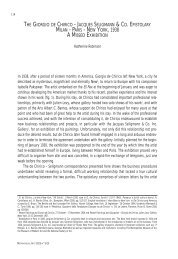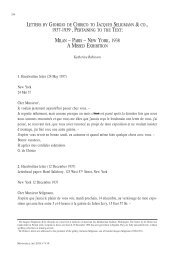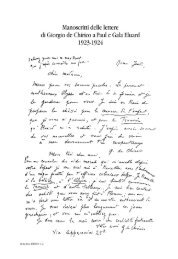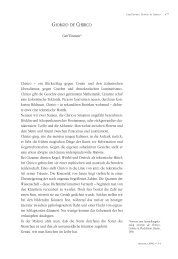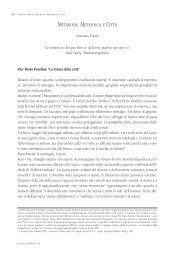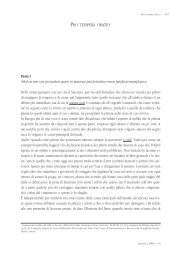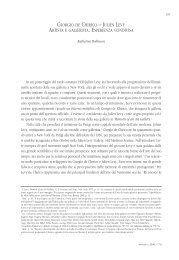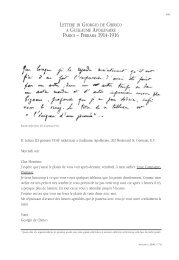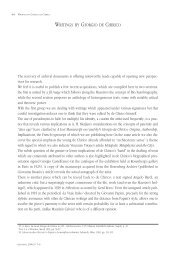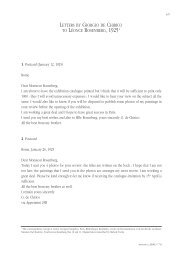293-356_08_Robinson ok.qxp - Fondazione Giorgio e Isa de Chirico
293-356_08_Robinson ok.qxp - Fondazione Giorgio e Isa de Chirico
293-356_08_Robinson ok.qxp - Fondazione Giorgio e Isa de Chirico
Create successful ePaper yourself
Turn your PDF publications into a flip-book with our unique Google optimized e-Paper software.
354KATHERINE ROBINSON: GIORGIO DE CHIRICO – JULIEN LEVY. ARTIST AND ART DEALER. SHARED EXPERIENCEhistorical and contemporary art movements. Sixteen paintings and ten drawings from <strong>de</strong> <strong>Chirico</strong>’s firstperiod were exhibited 115 in the section 20th Century Pioneers. 116In the years to come, the flow of attention surrounding <strong>de</strong> <strong>Chirico</strong> continued to broa<strong>de</strong>n even further,although with a clear division between two distinct shores: the institutionalization and theoreticalcategorization of his youthful production and the fervent pulse of his work in progress. This divisionof the Maestro’s oeuvre has been somewhat more marked in North America than in Europe, where artcritics have taken his mature work into serious consi<strong>de</strong>ration. 117 In any event, the distinction of his artinto separate periods is a <strong>de</strong>finition which has primarily benefited the art market, at the expense of theartist and culture, in general. Art critic James Thrall Soby was <strong>de</strong>cisive in confirming the bias instigatedin the first place by the surrealists. In his research on <strong>de</strong> <strong>Chirico</strong>, Soby <strong>de</strong>dicated himself exclusively tothe study and individuation of works from the early period, becoming an authority of this period towhom collectors, museums and amateurs have always referred. Following a critical approach based onpainting’s formal themes and concepts, it is conceivable that Soby may have failed to perceive the mysteriousand spiritual element of artistic creation, which is something that elu<strong>de</strong>s formal conceptualization.This unexplainable phenomenon is perhaps more easily grasped by a unique sensitivity congenitalin artists themselves. A letter Soby wrote to Carlo Ragghianti on April 27, 1950, in which he speaksof the arduous task of dating <strong>de</strong> <strong>Chirico</strong>’s early period paintings, is significant. In closing, he shares aperplexity he has: “What interests me very much is that <strong>de</strong> <strong>Chirico</strong>’s reputation, here and in France,has survived the <strong>de</strong>cline of interest in Surrealism. Oddly enough he is greatly admired by the moreadvanced younger American painters, though a principle premise of these painters – many of themabstract in the ‘spontaneous’ manner of the early Kandinsky – is that they insist on the two-dimensionallimitations of the canvas and are opposed to illusionistic perspective, particularly when linear, aswith the early <strong>de</strong> <strong>Chirico</strong>. They are especially contemptuous of the use of far perspective for emotionalor poetic effect. And yet they seem to admire <strong>de</strong> <strong>Chirico</strong>! At least some of them do.” 118The exhibition at the Julien Levy Gallery in 1936 provi<strong>de</strong>d continuity to the public’s knowledge of <strong>de</strong><strong>Chirico</strong>’s recent work, as well as introducing the artist to the American art market. The exhibition’s success,even in economic terms, permitted <strong>de</strong> <strong>Chirico</strong> to prolong his stay in America and to work with tranquillityin a land he had <strong>de</strong>fined as “another world”. Just as Julien Levy had perceived the unexpected apparitionof a Metaphysical Interior on the wall of his gallery as a propitious sign 119 , for <strong>Giorgio</strong> <strong>de</strong> <strong>Chirico</strong>, the fortunateopportunity of working with an art <strong>de</strong>aler gifted with an authentic passion for artistic research andpronounced human sensitivity undoubtedly provi<strong>de</strong>d an important base for his American adventure. 120While art critics, museums and merchants drew a distinct line between the artist and the paintings he had115Along with two paintings from the Museum’s collection and two anonymous loans, were works lent by James Thrall Soby, Cornelius N. Bliss, AndréBreton, Henry Clifford, Paul Eluard, Mario Broglio and René Gaffé (the painting lent by Gaffé, Still Life, was later disowned by <strong>de</strong> <strong>Chirico</strong>).116In addition to <strong>de</strong> <strong>Chirico</strong>, the section 20th Century Pioneers inclu<strong>de</strong>d the work of: Chagall, Duchamp, Kandinsky, Klee and Picasso. The sectionDada and Surrealism comprised the work of over fifty artists.117See. E. Adams, Dealing Late <strong>de</strong> <strong>Chirico</strong>: The Julien Levy Gallery, 1936-37, in De <strong>Chirico</strong> and America, cit., regarding the reaction of European artcritics to the exhibition De <strong>Chirico</strong>, MoMA, March 30 – June 29, 1982, p. 84, note 44.118J. Thrall Soby to C. Ragghianti, April 27, 1950, copy of typescript letter, James Thrall Soby Papers, VII.III.B.2.c.i. The Museum of Mo<strong>de</strong>rn Art Archives, New York.119See note 1.120Levy continued to <strong>de</strong>al with <strong>de</strong> <strong>Chirico</strong>’s art in the years that followed. Numerous sales of drawings, gouaches, watercolours and paintings of subjectspresented in the 1936 and 1937 exhibitions at the Levy Gallery, are marked in the gallery ledgers. Levy also <strong>de</strong>alt with the sale of a number ofworks from <strong>de</strong> <strong>Chirico</strong>’s first period. In addition to Evangelical Still Life, 1916 from the Lifar Collection, sold at the beginning of 1934 to S. Janis, weMETAFISICA 20<strong>08</strong>|N° 7-8



